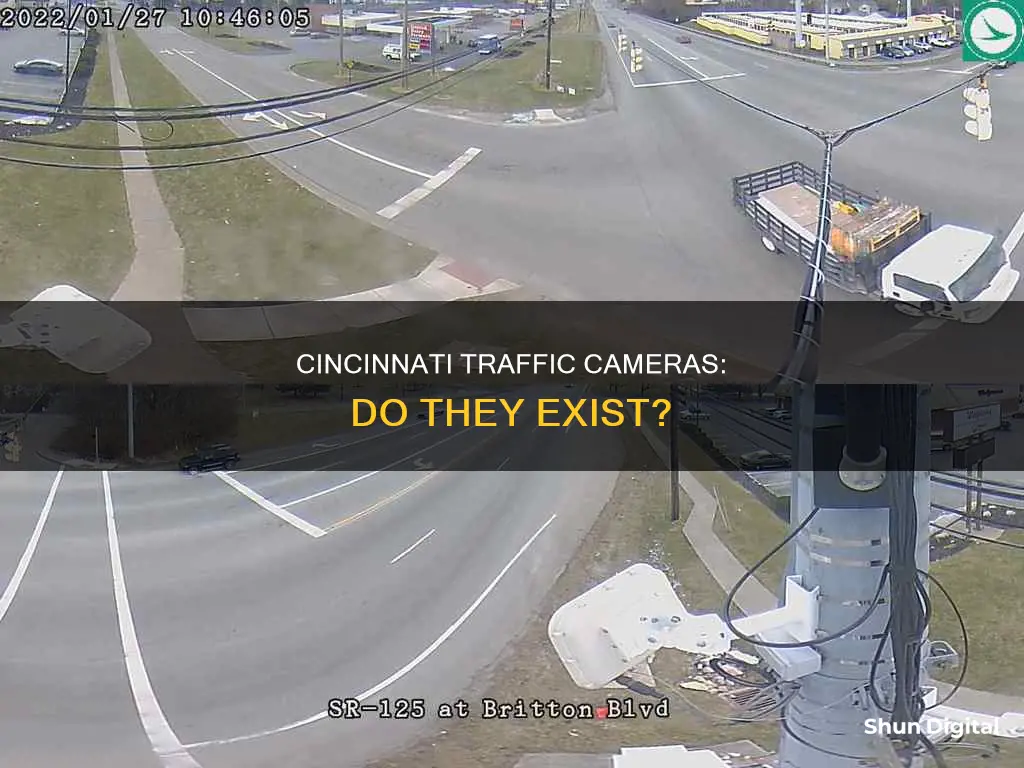
The use of traffic cameras in Cincinnati has been a controversial topic. While some community activists argue that traffic cameras could reduce pedestrian deaths, the city charter currently bans their use due to concerns about their potential for disproportionately impacting minority communities and being used as a tool for policing and profit. Despite this, some city leaders have attempted to bring the issue to a vote, and it remains a subject of debate among Cincinnati residents.
| Characteristics | Values |
|---|---|
| Traffic cameras banned? | Yes |
| Traffic cameras in use? | No |
| Live traffic cameras available? | Yes |
| Traffic enforcement cameras used? | No |
| Red-light cameras used? | No |
| Speed cameras used? | No |
| Traffic cameras supported by council committee? | No |
| Traffic cameras supported by council members? | Yes |
| Traffic cameras supported by community activists? | Yes |
| Traffic cameras opposed by community activists? | Yes |
| Traffic cameras supported by Cincinnati NAACP? | No |
| Traffic cameras may reduce? | Pedestrian deaths |
| OHGO app provides | Real-time traffic updates, personalized route notifications, live traffic cameras and accurate delay times |
What You'll Learn
- Cincinnati's council committee voted against traffic enforcement cameras
- Community activists may ask voters to overturn the ban
- Some believe cameras could reduce pedestrian deaths
- The NAACP is against the idea due to its potential to disproportionately affect minorities
- Councilman Greg Landsman proposed the use of traffic enforcement cameras

Cincinnati's council committee voted against traffic enforcement cameras
In 2008, Cincinnati voters passed a charter amendment that severely restricted the use of red-light cameras. However, in 2023, Councilman Jeff Cramerding proposed undoing the ban in a charter amendment that would have been put to voters in November. The proposal called for a repeal of the 2008 ban on traffic cameras, which passed with 51% of the vote.
Cramerding's motion needed to be approved by six members of the council before it could be put on the ballot for voters to decide. However, the measure failed 4-0 in the council's Law and Public Safety Committee, with Vice Mayor Jan-Michele Lemon Kearney and Council Members Scotty Johnson, Mark Jeffreys, and Liz Keating against the idea. This means that it will not advance to the full council.
Jeffreys suggested that the idea could be brought back for the spring 2024 election, stating that there is a path forward to exploring cameras, but it needs to be done right. He wants to ask the administration for more information and listen to citizen concerns, emphasizing the need for mutual trust.
The debate around traffic cameras in Cincinnati has sparked multiple times since the 2008 ban, with some arguing that it would help enforce traffic laws and free up police officers for other work, while others counterargue that it would disproportionately affect minority communities and cause an imbalance in policing in Black communities.
Straightening Your Cobra Surveillance Camera: A Step-by-Step Guide
You may want to see also

Community activists may ask voters to overturn the ban
In Cincinnati, Ohio, community activists may ask voters to overturn the ban on using cameras to enforce traffic laws. In 2008, Cincinnati voters passed a charter amendment that severely restricted the use of red-light cameras. However, in 2024, Councilman Jeff Cramerding proposed undoing the ban through a charter amendment that would be put to voters. Cramerding's amendment would have repealed the 2008 law and allowed the city to use traffic-enforcement cameras to issue citations. The measure failed 4-0 in the council's Law and Public Safety Committee, with opposition from Vice Mayor Jan-Michele Lemon Kearney and Council Members Scotty Johnson, Mark Jeffreys, and Liz Keating. Despite this setback, there is still a path forward for exploring the use of cameras, and the idea could be revisited for the spring 2024 election.
Community activists in favor of overturning the ban argue that it would make the streets safer and provide funding for traffic-calming measures like crosswalks and bump-outs. Councilman Cramerding has encountered many voters who supported the traffic camera ban in 2008 but have since changed their minds. However, there is also opposition to the idea from the Cincinnati NAACP, who argue that camera programs often disproportionately affect minority communities.
The debate over the use of traffic enforcement cameras in Cincinnati highlights the complex nature of the issue. While some see it as a way to improve traffic safety and reduce accidents, others raise concerns about the potential for disproportionate impact on minority communities. As the discussion continues, it remains to be seen whether community activists will succeed in convincing voters to overturn the ban and allow the use of cameras for traffic enforcement in Cincinnati.
The impact of such a ban would be far-reaching. It would affect the day-to-day lives of Cincinnati residents, as well as the work of the police and other emergency services. The ban also has implications for the city's budget, as the revenue from traffic citations can be significant. The debate is an important one, and it is essential that the voices of all stakeholders, including community activists, are heard and considered in the decision-making process.
RAW vs DNG: Why You Should Make the Switch
You may want to see also

Some believe cameras could reduce pedestrian deaths
In 2023, a Cincinnati council committee rejected the idea of using cameras to enforce traffic laws. However, some believe that traffic enforcement cameras can play a crucial role in reducing pedestrian deaths.
Traffic collisions are a leading cause of violent fatalities worldwide, and pedestrians are among the most vulnerable road users. While walking is promoted in urban areas to reduce the negative impacts of motor vehicles, ensuring pedestrian safety is paramount. Traffic enforcement cameras have been shown to address vehicle-to-vehicle collisions, but their effectiveness in reducing vehicle-pedestrian incidents is less understood.
A study in Medellín, Colombia, examined the relationship between traffic enforcement cameras and the severity of vehicle-pedestrian collisions. The results showed a mixed effect, indicating that while cameras alone may not be the solution, they can be a valuable tool when combined with other measures.
Another study in Barcelona found that speed cameras installed in an urban setting effectively reduced road collisions and the number of injured people and vehicles involved in collisions. This suggests that enforcement cameras can play a role in reducing the severity of vehicle-pedestrian collisions and improving overall traffic safety.
While critics argue that speed cameras can be a financial burden, advocates emphasize their life-saving potential. They argue that automated enforcement works, changing driver behaviour and making roads safer.
As cities like Richmond, Virginia, and New York City adopt speed cameras, it provides an opportunity to evaluate their effectiveness in reducing pedestrian deaths. While some critics argue that these programs can disproportionately affect minority communities and be a revenue-generating tool for cities, advocates counter that they offer a neutral alternative to police stops and reduce unnecessary interactions between police and communities of colour.
The debate around traffic enforcement cameras is complex, and further research is needed to understand their full impact on pedestrian safety. However, with traffic fatalities on the rise, many are desperate for solutions, and enforcement cameras may be part of a comprehensive approach to reducing pedestrian deaths and creating safer roads for all users.
Activating Standby Mode: A Simple Guide for Your Camera
You may want to see also

The NAACP is against the idea due to its potential to disproportionately affect minorities
In Cincinnati, Ohio, the use of traffic cameras to enforce traffic laws has been a topic of debate. While some council members have proposed undoing the 2008 ban on red-light cameras, the idea has faced opposition from the local NAACP chapter due to concerns about its potential to disproportionately impact minority communities.
The NAACP's stance against traffic enforcement cameras is rooted in the history of racial bias and disparate treatment experienced by African Americans and other racial and ethnic minorities in the criminal justice system. They argue that these camera programs often result in increased surveillance and targeting of minority communities, leading to a higher number of traffic stops, citations, and fines for individuals from these groups. This, in turn, perpetuates a cycle of over-policing and exacerbates existing racial inequalities.
Evidence from other cities supports the NAACP's concerns, indicating that the presence of red-light cameras disproportionately affects minority communities. The placement of these cameras in predominantly Black and brown communities further contributes to the perception of unfair targeting. The NAACP emphasizes that there are alternative approaches to improving traffic safety, such as investing in infrastructure improvements and traffic calming measures, rather than relying solely on punitive measures that may infringe on civil rights.
Additionally, the financial burden of traffic fines can disproportionately impact low-income individuals and families, pushing them further into poverty. The NAACP also raises privacy concerns, as these cameras capture not only vehicles but also the individuals inside, potentially invading their privacy without sufficient oversight.
The NAACP's opposition to traffic enforcement cameras in Cincinnati highlights the need to address traffic safety while also ensuring equitable treatment and upholding civil rights for all communities, especially those that have been marginalized and over-policed in the past.
The Camera Conundrum: Why No One Cares Anymore
You may want to see also

Councilman Greg Landsman proposed the use of traffic enforcement cameras
In 2023, Cincinnati City Council member Greg Landsman proposed legislation to address the rising number of pedestrian deaths caused by traffic accidents. Landsman's proposal included several components, one of which was the purchase of handheld cameras for the Cincinnati Police Department. These cameras would be used to capture information on speeding vehicles and automatically generate citations.
The proposal came in response to a series of tragic incidents involving pedestrians being struck by cars in Cincinnati. One notable case was the death of 15-year-old Gabby Rodriguez, who was hit by two vehicles on her way to school and did not survive her injuries. Another incident involved a 2-year-old, Dameon Turner, who was killed while being pushed in a stroller on the Hopple Street Viaduct by a driver under the influence of drugs.
The issue of pedestrian safety has become critical, with an increasing number of injuries and fatalities in recent years. In 2022, cars struck over 425 pedestrians in Cincinnati, almost double the number recorded five years prior. Of those incidents, seven people lost their lives.
Councilman Landsman's proposal for the use of traffic enforcement cameras is part of a broader approach to traffic safety known as "Vision Zero." This approach, which originated in Sweden in the late 1990s, treats fatalities from automobile-related incidents as entirely avoidable. It calls for data-driven action plans with finite timelines to achieve zero traffic fatalities. Cities like New York, San Diego, and Austin have already adopted this approach, with Austin seeing a 25% decrease in traffic deaths over two years.
While the proposal for traffic enforcement cameras did not advance to a full council vote, with some council members expressing concerns about mutual trust and the potential disproportionate impact on minority communities, Councilman Landsman continues to advocate for comprehensive solutions to improve traffic safety and protect children and families in Cincinnati.
Old Cameras: Ancient Computers or Not?
You may want to see also
Frequently asked questions
No, traffic cameras are banned in Cincinnati.
In 2008, Cincinnati voters passed a charter amendment that severely restricted the use of red-light cameras.
Community activists may ask voters to overturn the ban. A ballot measure to undo the ban was proposed by Councilman Jeff Cramerding but failed to get the required number of council members to sign off.







